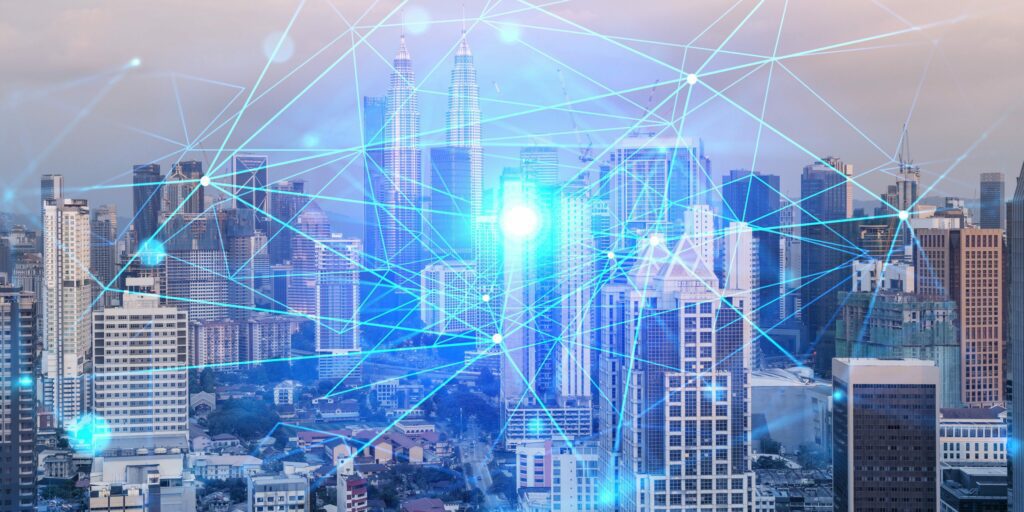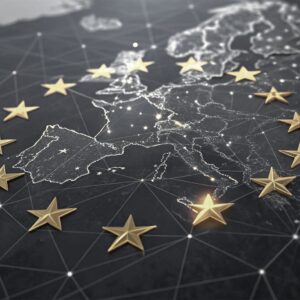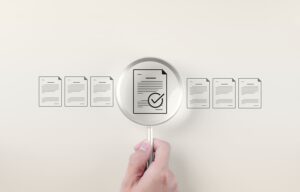Digitalization is greatly changing the starting point and the possibilities of a service offering. However, digital transformation is not the only driver of change. Increasing demands on the sustainability of a building, the globalization of the real estate market or the general competitive pressure are also influencing factors. The sustainability of a property and the focus on customer needs are moving to center stage. Energy reduction, circular economy, response times, transparency, and the need for information are just a few keywords that are always on the minds of our customers and stakeholders.
With a potential analysis of the technological drivers in the real estate industry, we were able to show in interviews with leading service providers and investors that especially the two drivers data and platforms seem to be very promising in the medium term. The concept of the Digital Twin is based precisely on these two most relevant factors. Data from various sources is collected and made available in a central location. Of course, intelligence and other technologies are also needed to round off the concept.
What is a Digital Twin?
The word “Digital Twin” was first used by NASA in a report in 2010 on the Apollo 13 mission. It is interesting to note that the Apollo 13 mission took place 50 years ago. Even then, NASA accurately replicated the systems on the ground for problem solving and fed them with “real-time data” from the flying original. We define the digital twin as follows:
- A Digital Twin is a true-to-life digital representation of a physical object.
- The Digital Twin enables parameters, information and real-time data as well as target and purpose of an object
- The Digital Twin can be used to map, predict and optimize the performance, behavior and use of an object.
In the meantime, there are already countless applications of Digital Twins:
- Data-driven twins of entire cities are being created with diverse information from zoning maps, building information, green spaces, building lines and much more.
- The industry is creating digital twins of products or even production lines to better adapt products to customer needs via various feedback loops and thus take fewer risks. Companies are constantly optimizing and monitoring their entire production (reducing production downtime, optimizing lead times, etc.). Digital Twins open up great potential in all areas, whether for simple consumer goods or complex products such as cars, airplanes or even wind turbines.
- This also applies to people: They create images of themselves in social media (LindekIn, Facebook, Instagram, etc.) and feed them with information, sometimes on a daily basis. But digital avatars are also being created in medicine for faster examinations, more accurate remote diagnoses, or even for analyzing the effect and side effect of drugs in advance.
But what about real estate?
What is a Digital Twin and what role does it play in the real estate industry? Real estate is not comparable to normal goods. There are three main differences:
- Lifetime
- Cost allocation over the lifetime (20/80)
- Individuality of each product
Digital Twin for real estate explained using the real estate life cycle
Even before construction, the DT is created and fed with as much information as possible in order to create an image of the future property already in this phase. This image enables the development of variants at an early stage. This means that the property can be sold even before it is actually built. The client knows exactly what he is buying and experiences no unpleasant surprises later. This significantly reduces the time-to-market. Later expenses due to subsequent adjustments are avoided during or after the construction period.
Virtual construction site with BIM and supply chain
In preparation for realization, the construction site can already be virtually built, tested and optimized. Most of the data for this comes from the Building Information Model (BIM), but can be supplemented by additional data from the entire construction ecosystem. In this way, the entire supply chain is modeled across the entire construction site. The space required for the entire construction site is also reduced, which is particularly advantageous in the tight space conditions in urban regions. The cost allocation, until completion can be predicted and thus financing can be secured at an early stage.
The digital twin also offers optimization opportunities during construction. Just-in-time deliveries are planned and continuously adjusted to the effective construction progress. Delays can be coordinated directly with subsequent steps. Work steps with expensive construction machinery are planned, their use improved and waiting times reduced. Augmented reality (AR) and virtual reality (VR) are used to compare virtual planning with construction on site and to detect and correct errors directly. This is particularly the case for elements that are no longer visible during acceptance and may later result in high follow-up costs.
What could the future look like now?
When it comes to virtual reality, visions of the future are inevitable. Together we considered: How could VR continue to develop in business? We are certain of one thing: VR technology will not simply disappear again. Why do we believe this? On the one hand it shows us, the investment of the big technology companies in VR, on the other hand we see great opportunities for the “New Way of Working”. Not to forget the financial and sustainable advantage that an on-site presence is no longer necessary and that I can avoid a flight, for example. In part, these possibilities are already visible, such as in the use of VR glasses for innovative workshops, but above all we still see great potential for innovation and optimization, whether in the design of the glasses or in the configuration of the metaverse. This could still contribute to one of the biggest changes in the current way of working.
If we continue to spin our visions, one of our future scenarios is to have VR glasses on every workstation in the next few years, and that is then as natural as our headset, mouse or keyboard is today. If we choose a disruptive approach, even screens in the office could disappear completely and the workspaces as we know them today could change in a revolutionary way. Then our office will be more like a cozy lounge where people meet for a coffee and wear their VR glasses in comfortable armchairs for three to four hours until they want to quickly meet up with Ms. Müller at the real coffee machine.
How do real estate companies add value with a digital twin?
However, just collecting data is not enough. The main goal of the digital twin is to create added value. But how? Basically, there are three ways:
- Internal optimization, such as increasing efficiency and reducing costs
- Improving the customer experience, or creating new customer experiences
- Or the combination of these two points in the context of identifying new services or even new business models
The digital twin and, above all, the linking of the various data sources to form an overall view form the basis for this. The digital twin is an enabler to really create added value from data. The approach can be two-sided. On the one hand, with the identification of use cases and the derivation of the required data sources, on the other hand, with the analysis of the combined data sources with data analytics and the insights thus gained for the creation of use cases.
How is a Digital Twin implemented technically?
These are the most important elements in the chain from the data source to the desired output:
- Different data sources require different interfaces (ERP system, building management system, BIM, IoT) à protocols, batches, events, etc.
- The raw data is stored in the digital twin. However, they cannot yet be used directly due to the different way they are used and first need processing. With the transformation, the data is processed so that it can be provided in a data model.
- Access from the services, the target systems or APIs is made to the DataLake, the Data Warehouse or DataMarts. This implementation of the provisioning layer is strongly dependent on the corresponding target service and its requirements.
It is imperative to consider the elements in the area of data security: cyber security & privacy, data governance and data access. These areas are elementary for sustainable use of the system and are often addressed too late.
Eraneos has some project experience from the strategic considerations to and with the implementation. We would like to share four tips with you:
- Architecture: think big
The architecture should be flexible and designed for later extensions. Cost and requirement driving cases should be considered, the so-called edge cases - Use Cases: start small
Identify a use case with which you can achieve initial added value and implement it as a proof of concept for the architecture, preferably with Minimum Viable Products MVPs. - Data: data to value
In the first step, only integrate the sources that are really relevant to the case. Identify the right data model(s) for your application purposes. Especially for real estate a semantic model can be interesting for the allocation of data to a building structure. - Security: security first
You work with a lot of business relevant and personal data. Consider security issues from the beginning and involve experts.



